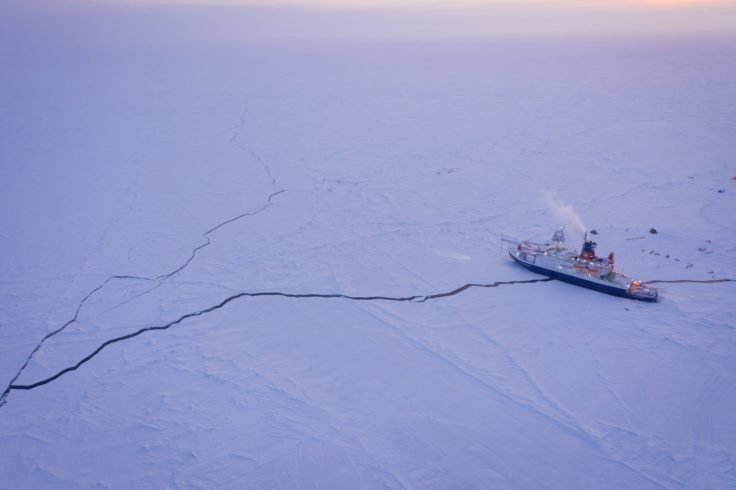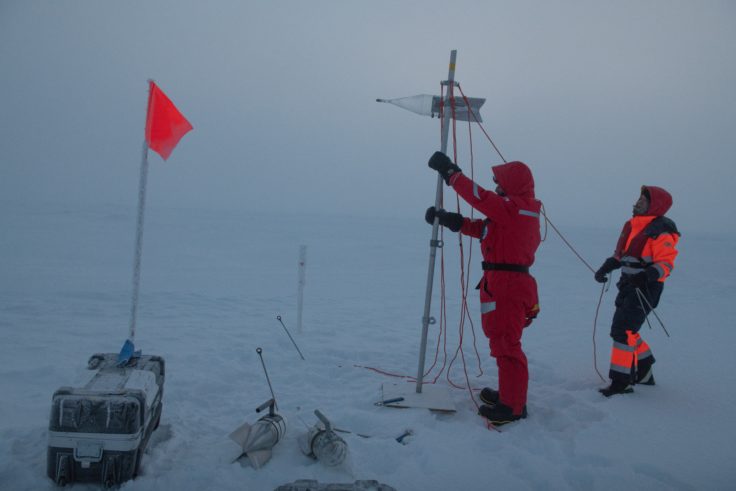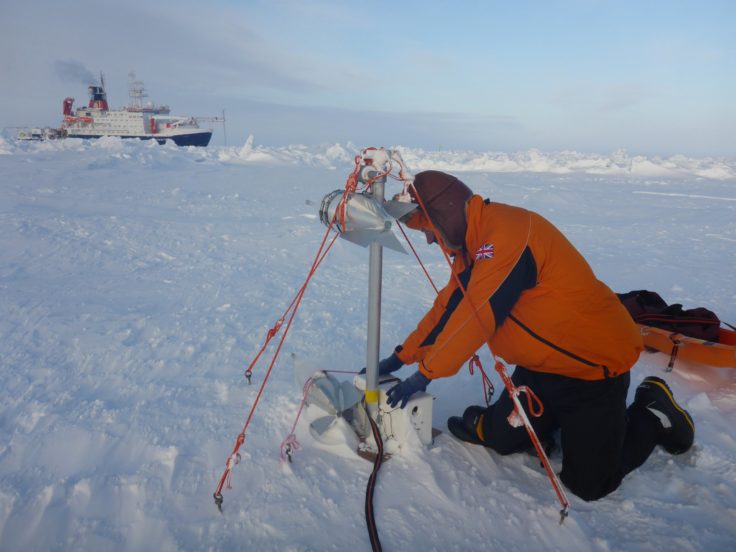Deep insight into Arctic from MOSAiC expedition
New research papers from the one-year MOSAiC expedition to study the Arctic have yielded new understanding about the region.
Hundreds of international researchers are currently analysing observations from the MOSAiC expedition, during which hundreds of environmental parameters were recorded with unprecedented accuracy and frequency over a full annual cycle in the Central Arctic Ocean. The group has now published three overview articles on the MOSAiC atmosphere, snow and sea ice, and ocean programmes in the journal Elementa, which highlight the importance of examining all components of the climate system together. These results present the first complete picture of the climate processes in the central Arctic, which affect weather and climate worldwide. The three overview articles serve as references for a vast array of future scientific work.

Diminishing sea ice is a symbol of ongoing global warming: in the Arctic, its extent has almost halved in summer since satellite records began in the 1980s. Less well studied but equally relevant are the thickness and other properties of the ice. The question of what changing sea ice means for the future Arctic, and how these changes will affect the global climate, were the impetus for the historic MOSAiC expedition with the German research icebreaker RV Polarstern from September 2019 to October 2020. With the results coming out now, the researchers are building the most complete observation-based picture of climate processes in the Arctic, where the surface air temperature has been rising more than two times as fast as on the rest of the planet since the 1970s.
To study the relevant processes for a full year required a special concept, in part because the Central Arctic Ocean is still ice-covered in winter and therefore difficult to access. During the expedition, the icebreaker froze to a large ice floe and drifted with the natural transpolar drift across the Arctic Ocean. And this is where the first surprises came.
“We found more dynamic and faster drifting pack ice than expected. This not only challenged the teams on the ground in their daily work, but above all resulted in changed sea-ice properties and sea-ice thickness distributions,” reports Dr Marcel Nicolaus, sea-ice physicist at the Alfred Wegener Institute, Helmholtz Centre for Polar and Marine Research (AWI) and co-leader of Team Ice in the MOSAiC project.

One of the reasons for the rapid drift is provided by the atmospheric research team’s analysis. “Near the surface there were particularly low temperatures and associated persistent strong winds in the winter months that pushed Polarstern faster than expected. Large-scale atmospheric pressure and wind patterns in January to March led to a particularly strong polar vortex around the Arctic, in addition to a record ozone hole in the Arctic stratosphere,” explains Dr Matthew Shupe, atmospheric scientist at CIRES at the University of Colorado and NOAA and co-leader of Team Atmosphere.
“The physical observations are the basis for interpreting biogeochemical cycles and ecosystem processes, and for supporting coupled models that we use to learn even more about climate feedbacks and the global repercussions of Arctic change. These changes can affect weather and climate worldwide,” says Prof. Markus Rex, head of MOSAiC and atmospheric scientist at the AWI.
“It is fascinating how accurately we can map individual processes and relate them to each other. I am pleased to see how several hundred MOSAiC participants have collaborated on these publications. International cooperation with expedition participants from so many countries continues productively in a highly coordinated manner, even though the expedition has been over for more than a year. In this way, we will be able to provide ever more important insights into climate change, which will provide a knowledge base for societal transformation towards a sustainable approach to planet Earth,” says MOSAiC leader Markus Rex.
BAS scientists Dr Amélie Kirchgaessner and Dr Markus Frey, from the Atmosphere, Ice and Climate team, worked on MOSAiC. They set up equipment in the new BAS Atmospheric Container Laboratory on board RV Polarstern, and on the sea ice, to measure tiny atmospheric particles to better understand the interaction between the ocean, sea ice, snow and atmosphere. For example rocket traps, which collect snow blown into them, were attached to poles in the ice at three different heights. By collecting and measuring chemical and physical properties of the captured snow, the scientists were able to determine the origin of particles in the snow and their importance for the formation of clouds.
Dr Markus Frey from BAS spent four and a half months from winter into summer working on the expedition. He says:
“MOSAiC provided us with the unique opportunity to study the coupled ocean-sea ice-snow-atmosphere system in the central Arctic for an entire year. During and after storms in winter/spring we observed frequent increases in sea salt particles associated with drifting and blowing salty snow. I was surprised to see a very dynamic sea ice surface with dramatic leads opening and ridging on a daily basis already in late winter and early spring when on board RV Polarstern. We are currently investigating the impact of the sea ice surface and its variability as a source of sea salt and cloud forming particles, and links to clouds and climate.”

Dr Amelie Kirchgaessner joined the ship for the initial phase of the expedition to set up equipment and ensure continuous year-round measurements.
She says:
“My interest is to find out more about sea salt aerosol. We need to know what its sources are, its pathways and its impact on clouds in the Arctic climate system. Our measurements of snow samples, traps that capture blowing snow, and snow particle counters on a mast, provide information about how sea salt finds its way into the atmosphere. Additionally we captured sea salt and other aerosol particles on filters. We are currently analysing the filters to find out how well ice crystals form on these aerosol particles. This tells us how important they are for the formation of clouds.”
Dr Kirchgaessner and Dr Frey’s research during the MOSAiC Expedition was funded as part of a joint £2.3m initiative between the Natural Environment Research Council and the Department for Business, Energy and Industrial Strategy. Details on all the seven UK-based teams supported through this initiative are available here: https://www.arctic.ac.uk/research/mosaic/
Background information on MOSAiC
During the Multidisciplinary drifting Observatory for the Study of Arctic Climate (MOSAiC) expedition, experts from 20 nations explored the Arctic for an entire year. From autumn 2019 to autumn 2020, the German research icebreaker Polarstern drifted frozen in the ice through the Arctic Ocean. MOSAiC was coordinated by the Alfred Wegener Institute, Helmholtz Centre for Polar and Marine Research (AWI). In order to make this unique project a success and to obtain the most valuable data possible, more than 80 institutes had pooled their resources in a research consortium. The total cost of the expedition was about 150 million euros, mostly funded by the German Federal Ministry of Education and Research.
Original publications
Nicolaus, M, Perovich, DK, Spreen, G, Granskog, MA, Albedyll, LV, Angelopoulos, M, Anhaus, P, Arndt, S, Belter, HJ, Bessonov, V, Birnbaum, G, Brauchle, J, Calmer, R, Cardellach, E, Cheng, B, Clemens-Sewall, D, Dadic, R, Damm, E, de Boer, G, Demir, O, Dethloff, K, Divine, DV, Fong, AA, Fons, S, Frey, MM, Fuchs, N, Gabarro, C, Gerland, S, Goessling, HF, Gradinger, R, Haapala, J, Haas, C, Hamilton, J, Hannula, H-R, Hendricks, S, Herber, A, Heuzé, C, Hoppmann, M, H yland, KV, Huntemann, M, Hutchings, JK, Hwang, B, Itkin, P, Jacobi, H-W, Jaggi, M, Jutila, A, Kaleschke, L, Katlein, C, Kolabutin, N, Krampe, D, Kristensen, SS, Krumpen, T, Kurtz, N, Lampert, A, Lange, BA, Lei, R, Light, B, Linhardt, F, Liston, GE, Loose, B, Macfarlane, AR, Mahmud, M, Matero, IO, Maus, S, Morgenstern, A, Naderpour, R, Nandan,V, Niubom, A, Oggier, M, Oppelt, N, Pa tzold, F, Perron, C, Petrovsky,T, Pirazzini, R, Polashenski, C, Rabe, B, Raphael, IA, Regnery, J, Rex, M, Ricker, R, Riemann-Campe, K, Rinke, A, Rohde, J, Salganik, E, Scharien, RK, Schiller, M, Schneebeli, M, Semmling, M, Shimanchuk, E, Shupe, MD, Smith, MM, Smolyanitsky,V, Sokolov,V, Stanton, T, Stroeve, J,Thielke, L,Timofeeva, A,Tonboe, RT,Tavri, A,Tsamados, M,Wagner, DN,Watkins, D,Webster, M,Wendisch, M. 2022. Overview of the MOSAiC expedition: Snow and sea ice. Elementa: Science of the Anthropocene 10(1). DOI: https://doi.org/10.1525/elementa.2021.000046
Shupe, M.D., M. Rex, B. Blomquist, P.O.G. Persson, J. Schmale, T. Uttal, D. Althausen, H. Angot, S. Archer, L. Bariteau, I. Beck, J. Bilberry, S. Bussi, C. Buck, M. Boyer, Z. Brasseur, I.M. Brooks, R. Calmer, J. Cassano, V. Castro, D. Chu, D. Costa, C.J. Cox, J. Creamean, S. Crewell, S. Dahlke, E. Damm, G. de Boer, H. Deckelmann, K. Dethloff, M. Dütsch, K. Ebell, A. Ehrlich, J. Ellis, R. Engelmann, A.A. Fong, M.M. Frey, M.R. Gallagher, L. Ganzeveld, R. Gradinger, J. Graeser, V. Greenamyer, H. Griesche, S. Griffiths, J. Hamilton, G. Heinemann, D. Helmig, A. Herber, C. Heuzé, J. Hofer, T. Houchens, D. Howard, J. Inoue, H.-W. Jacobi, R. Jaiser, T. Jokinen, O. Jourdan, G. Jozef, W. King, A. Kirchgaessner, M. Klingebiel, M. Krassovski, T. Krumpen, A. Lampert, W. Landing, T. Laurila, D. Lawrence, B. Loose, M. Lonardi, C. Lüpkes, M. Maahn, A. Macke, W. Maslowski, C. Marsay, M. Maturilli, M. Mech, S. Morris, M. Moser, M. Nicolaus, P. Ortega, J. Osborn, F. Pätzold, D.K. Perovich, T. Petäjä, C. Pilz, R. Pirazzini, K. Posman, H. Powers, K.A. Pratt, A. Preußer, L. Quéléver, M. Radenz, B. Rabe, A. Rinke, T. Sachs, A. Schulz, H. Siebert, T. Silva, A. Solomon, A. Sommerfeld, G. Spreen, M. Stephens, A. Stohl, G. Svensson, J. Uin, J. Viegas, C. Voigt, P. von der Gathen, B. Wehner, J.M. Welker, M. Wendisch, M. Werner, Z. Xie, F. Yue, 2022: Overview of the MOSAiC expedition – Atmosphere. Elementa, Science of the Anthropocene, 10 (1), doi: 10.1525/elementa.2021.00060.
Rabe, B, Heuzé, C, Regnery, J, Aksenov, Y, Allerholt, J, Athanase, M, Bai, Y, Basque, C, Bauch, D, Baumann, TM, Chen, D, Cole, ST, Craw, L, Davies, A, Damm, E, Dethloff, K, Divine, DV, Doglioni, F, Ebert, F, Fang, Y-C, Fer, I, Fong, AA, Gradinger, R, Granskog, MA, Graupner, R, Haas, C, He, H, He, Y, Hoppmann, M, Janout, M, Kadko, D, Kanzow, T, Karam, S, Kawaguchi, Y, Koenig, Z, Kong, B, Krishfield, RA, Krumpen, T, Kuhlmey, D, Kuznetsov, I, Lan, M, Laukert, G. Lei, R, Li, T, Torres-Valde ́s, S, Lin, L, Lin, L, Liu, H, Liu, N, Loose, B, Ma, X, MacKay, R, Mallet, M, Mallett, RDC, Maslowski, W, Mertens, C, Mohrholz, V, Muilwijk, M, Nicolaus, M, O’Brien, JK, Perovich, D, Ren, J, Rex, M, Ribeiro, N, Rinke, A, Schaffer, J, Schuffenhauer, I, Schulz, K, Shupe, MD, Shaw, W, Sokolov, V, Sommerfeld, A, Spreen, G, Stanton, T, Stephens, M, Su, J, Sukhikh, N, Sundfjord, A, Thomisch, K, Tippenhauer, S, Toole, JM, Vredenborg, M, Walter, M, Wang, H, Wang, L, Wang, Y, Wendisch, M, Zhao, J, Zhou, M, Zhu, J. 2022. Overview of the MOSAiC expedition: Physical oceanography. Elementa: Science of the Anthropocene 10(1). DOI: https://doi.org/10.1525/elementa.2021.00062
Short citations
ICE: Nicolaus, M, Perovich, DK, Spreen, G, Granskog, MA et al, 2022: Overview of the MOSAiC expedition: Snow and sea ice. Elementa: Science of the Anthropocene 10(1). DOI: https://doi.org/10.1525/elementa.2021.000046
OCEAN: Rabe, B, Heuzé, C, Regnery et al., 2022: Overview of the MOSAiC expedition – Atmosphere. Elementa, Science of the Anthropocene, 10 (1), doi: 10.1525/elementa.2021.00060.
ATMOS: Shupe, M.D., M. Rex, B. Blomquist, P.O.G. Persson, J. Schmale, T. Uttal et al., 2022: Overview of the MOSAiC expedition: Physical oceanography. Elementa: Science of the Anthropocene 10(1). DOI: https://doi.org/10.1525/elementa.2021.00062
Link to the BAS project page – a contribution to MOSAiC funded by NERC.